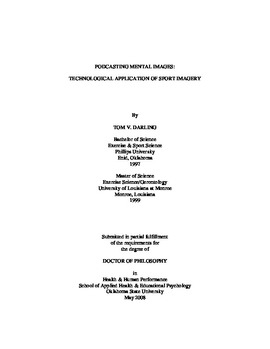| dc.contributor.advisor | Edwards, Steven W. | |
| dc.contributor.author | Darling, Tom V. | |
| dc.date.accessioned | 2013-11-26T08:34:21Z | |
| dc.date.available | 2013-11-26T08:34:21Z | |
| dc.date.issued | 2008-05 | |
| dc.identifier.uri | https://hdl.handle.net/11244/7361 | |
| dc.description.abstract | PURPOSE: The purpose of this study was to determine if podcasting can significantly increase FT shooting performance among high school basketball players. METHODS: The sample for the study included 36 (12 male, 24 female) Oklahoma high school basketball players. Subjects were assigned into four groups (script, computer, iPod, control group) and were tested in three phases (pretest, treatment, posttest). The treatment phase consisted of imagery training (via podcasting) and FT shooting for six weeks. RESULTS: A total of 200 FT shots for the experimental groups was analyzed and compared to a total of 50 FT shots for the control group. Surprisingly, there were no significant group differences found among the experimental groups at any of the six testing sessions. However, a comparison of group means and the grand mean for the six testing sessions did indicate that the iPod group (18.1) performed higher than the computer group (16.7) and the script group (16.2). Also, a one-way ANOVA of the posttest indicated that there were significant group mean differences [F (3, 32) = 3.221, p < .05, w = .40]. A Tukey post hoc test indicated that the true source of the significant group difference was between the iPod group and the control group. A comparison of posttest group means indicated that the iPod group (21.0) was the top performer, followed by the computer group (18.6), the script group (17.1), and the control group (15.8). Overall, the script group had the highest improvement (+ 3.8) and the control group had the lowest improvement (+ 0.7). CONCLUSION: Podcasting is a valid technological application of sport imagery that can improve FT shooting performance among high school basketball players. Podcasting is recommended as an adjunct to mental and physical training that can benefit sport psychologists, the coaching staff, and most importantly the athletes. | |
| dc.format | application/pdf | |
| dc.language | en_US | |
| dc.rights | Copyright is held by the author who has granted the Oklahoma State University Library the non-exclusive right to share this material in its institutional repository. Contact Digital Library Services at lib-dls@okstate.edu or 405-744-9161 for the permission policy on the use, reproduction or distribution of this material. | |
| dc.title | Podcasting mental images: Technological application of sport imagery | |
| dc.contributor.committeeMember | Smith, Doug B. | |
| dc.contributor.committeeMember | Davis, Charles R. | |
| dc.contributor.committeeMember | Stansberry, Susan L. | |
| osu.filename | Darling_okstate_0664D_2665.pdf | |
| osu.accesstype | Open Access | |
| dc.type.genre | Dissertation | |
| dc.type.material | Text | |
| dc.subject.keywords | sport imagery | |
| dc.subject.keywords | podcasting | |
| dc.subject.keywords | free throw | |
| dc.subject.keywords | basketball | |
| dc.subject.keywords | ipod | |
| thesis.degree.discipline | Health and Human Performance | |
| thesis.degree.grantor | Oklahoma State University | |
